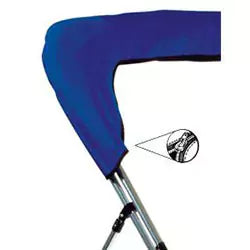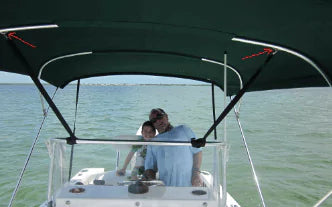How to fold down a bimini top

How to Fold Down a Bimini Top
Step-by-Step Guide
Step 1: Prepare the Area
Before you begin folding down your bimini top, it's essential to clear the surrounding area and make sure there is ample space for the process. Remove any items that may obstruct the folding or cause damage. It's advisable to perform this task on a calm day, as strong winds can make the process challenging.
Once the area is clear, ensure that the bimini top is in its fully extended position. This will make it easier to access and fold properly. Inspect the top for any debris, such as leaves or dirt, and brush them off gently. Next, check if the bimini top is dry. If it's wet, allow it to dry completely before proceeding with the folding process. This helps prevent mold and mildew growth during storage.
If your bimini top has any removable accessories, such as side curtains or storage boots, detach them carefully and store them separately. This will make the folding process more manageable and prevent any potential damage to these accessories.
By preparing the area and ensuring the bimini top is in good condition, you set the stage for a smooth and successful folding process. Taking these initial steps will help protect your bimini top and prolong its lifespan, ensuring it remains in excellent condition for your future boating adventures.
Remember to continue following the step-by-step guide to complete the process and safely store your bimini top when not in use.
Step 2: Loosen the Straps
Once you have prepared the area and ensured that your bimini top is in its fully extended position, it's time to move on to the next step: loosening the straps. The straps on your bimini top are designed to secure it in place while in use, but they need to be loosened before folding it down. Here's how to do it: Start by locating the straps that hold the bimini top in place. These straps are usually attached to the frame or support poles. Depending on the design of your bimini top, there may be multiple straps to loosen.
Using your hands or a suitable tool, release the tension on each strap. Carefully unfasten any buckles, snaps, or hooks securing the straps. Loosen them enough to provide flexibility and allow the fabric to fold without resistance.
Make sure to loosen all the straps evenly to maintain balance and prevent any unnecessary strain on the bimini top. Take your time to ensure that each strap is properly loosened, avoiding any abrupt movements that could potentially damage the top or its frame.

H3: Step 3: Fold the Fabric
With the straps loosened, you can now proceed to fold the fabric of the bimini top. Folding the fabric correctly is crucial to prevent creasing or damage. Here's how to do it effectively:
Start by identifying the center point of the bimini top fabric. This is typically where the frame hinges or folds. Gently lift the fabric from this center point to create a slight "V" shape.
Next, fold one side of the fabric over the center point, followed by the other side. Ensure that the fabric is neatly aligned and that there are no wrinkles or folds. Take your time to achieve a clean and even fold.
Once the fabric is folded, secure it in place using the provided straps or ties. Some bimini tops have built-in straps specifically designed for securing the folded fabric. If not, you can use bungee cords or ropes to keep the fabric in position.
By following these steps, you can effectively loosen the straps and fold the fabric of your bimini top. Properly folding the fabric ensures that it stays in good condition and reduces the risk of damage during storage. With the fabric securely folded, you can now move on to the next steps in the process of folding down your bimini top.

Step 4: Secure the Straps
After loosening the straps and folding the fabric of your bimini top, the next step is to secure the straps to keep everything in place. This ensures that the folded bimini top remains compact and prevents it from unfolding during storage or transport. Here's how to securely fasten the straps:
Begin by identifying the straps that were previously loosened. These straps are typically attached to the frame or support poles of the bimini top. Take each strap and pass it around the folded fabric, ensuring it is positioned snugly.
Secure the straps by reattaching the buckles, snaps, or hooks that were previously unfastened. Adjust the straps as needed to provide a firm yet not overly tight fit. The goal is to keep the folded fabric secure without causing any damage or strain.
Double-check that all the straps are properly fastened and tightened evenly. This helps maintain balance and stability during storage or transportation. It's crucial to ensure that no straps are left loose or hanging, as this can lead to potential damage or the bimini top unfolding unexpectedly.
Step 5: Collapse the Frame
With the straps securely fastened, it's time to collapse the frame of the bimini top. The frame is the supporting structure that holds the fabric in place when the top is extended. Here's how to collapse the frame effectively:
Start by locating the frame hinges or joints. These are typically found where the support poles connect to the mounting brackets or deck fittings. Gently release any locking mechanisms or pins that hold the frame in its extended position.
Carefully fold the support poles inward, following the natural folding direction of the frame. Depending on the design of your bimini top, you may need to collapse multiple sections of the frame simultaneously or individually.
As you collapse the frame, be mindful of any protruding parts or sharp edges that could cause injury or damage. Take your time to ensure a smooth and controlled folding motion, avoiding any sudden movements that could put unnecessary strain on the frame or fabric.
Once the frame is fully collapsed, secure any additional locking mechanisms or straps that are designed to keep it in place during storage or transport. These may include clips, straps, or Velcro fasteners
By following these steps, you can effectively secure the straps and collapse the frame of your bimini top. Properly securing the straps and folding the frame ensures a compact and secure storage position, keeping your bimini top protected and ready for future use.
Step 6: Store the Bimini Top
After securing the straps and collapsing the frame of your bimini top, the final step is to properly store it. Proper storage is essential for maintaining the integrity and longevity of your bimini top. Here's how to store it effectively:
Find a suitable storage location for your bimini top. Ideally, this should be a clean, dry, and well-ventilated area. Avoid storing it in direct sunlight or in a place prone to extreme temperatures, as this can cause damage to the fabric and frame over time.
Place the folded bimini top in its designated storage bag or cover. If your bimini top didn't come with a storage bag, use a large, breathable fabric cover to protect it from dust, dirt, and potential abrasions. Make sure the storage bag or cover is appropriately sized to accommodate the folded top without causing any unnecessary compression.
Avoid placing heavy objects on top of the stored bimini top, as this can lead to deformation or damage. Store it in a way that prevents any pressure or stress on the fabric or frame. If needed, use padding or cushions to provide additional protection.
If possible, store the bimini top in an upright position to prevent any potential sagging or misshaping. If this isn't feasible, make sure it's laid flat without any sharp bends or creases.
Regularly inspect the stored bimini top for any signs of damage, such as tears, mold, or mildew. If you notice any issues, address them promptly to prevent further deterioration.

Additional Tips and Considerations
Do Bimini Tops Fold Down?
Clean and dry your bimini top before storage to prevent the growth of mold and mildew. Use a mild soap and water solution to clean the fabric and allow it to air dry completely. Consider using additional protective covers or UV-resistant treatments to prolong the life of your bimini top. Follow the manufacturer's instructions for any specific storage recommendations or guidelines.
Take note of wind and weather conditions when storing your bimini top. If you anticipate strong winds or storms, consider securing it further or removing it entirely to prevent potential damage.
Ensure that you have adequate storage space for your bimini top. If storing it on a boat, make sure it is secure and won't shift during transportation.
By following these storage tips and considerations, you can keep your bimini top in excellent condition, ready for your next boating season or adventure. Regular maintenance and proper storage will help prolong its lifespan and ensure optimal performance when you need it.
Tip 1: Clean and Dry the Bimini Top
Keeping your bimini top clean and dry is essential for its maintenance and longevity. Before storing it, it's crucial to clean the fabric and ensure it's completely dry. Here's why this tip is important and how to implement it:
Cleaning the bimini top helps remove dirt, dust, salt residue, and other contaminants that can accumulate over time. Use a mild soap or detergent specifically formulated for marine fabrics. Gently scrub the fabric with a soft brush or sponge, paying attention to any stubborn stains or spots. Rinse thoroughly with clean water to remove all traces of soap.
Allow the bimini top to air dry completely before storing it. Moisture trapped in the fabric can lead to mold, mildew, and unpleasant odors. Hang the top in a well-ventilated area or lay it flat on a clean surface, ensuring that both sides receive adequate airflow.
It's important to note that different types of bimini top fabrics may have specific cleaning instructions. Refer to the manufacturer's guidelines for the recommended cleaning products and methods for your particular bimini top.

Tip 2: Use Protective Covers
Using protective covers is an effective way to shield your bimini top from environmental elements and potential damage during storage. Here's why this tip is beneficial and how to implement it:
Invest in a quality protective cover designed specifically for bimini tops. These covers are typically made from durable and water-resistant materials that offer protection against dust, dirt, UV rays, and moisture. Ensure that the cover is large enough to fully enclose the folded bimini top without causing unnecessary compression or stress.
When storing the bimini top, place it inside the protective cover and secure it properly. Some covers have drawstrings, straps, or zippers to provide a snug fit. Double-check that the cover is securely fastened to prevent it from coming loose during storage.
Protective covers not only shield the bimini top from physical damage but also help maintain its appearance and prolong its lifespan. They act as a barrier against sun exposure, preventing fading and deterioration of the fabric. Additionally, they reduce the risk of scratches or abrasions caused by other items stored in close proximity.
Regularly inspect the protective cover for any signs of wear or damage. If you notice any tears or weak spots, consider replacing it to ensure continued protection.
By implementing these tips, cleaning and drying the bimini top before storage and using a protective cover, you can keep your bimini top in excellent condition and extend its lifespan. These simple measures go a long way in preserving the appearance and functionality of your bimini top, ensuring many enjoyable boating experiences in the future.
Tip 3: Follow Manufacturer Instructions
When it comes to caring for your bimini top, it's crucial to follow the manufacturer's instructions. Each bimini top may have specific guidelines and recommendations for maintenance, cleaning, and storage. Here's why this tip is important and how to implement it:
The manufacturer's instructions are designed to ensure that you maintain and use your bimini top correctly, maximizing its lifespan and performance. These instructions may include specific cleaning products, techniques, and storage guidelines that are tailored to the materials and construction of your bimini top. Carefully read and understand the manufacturer's instructions provided with your bimini top. If the instructions are missing or unclear, reach out to the manufacturer directly for guidance. They are the experts on their product and can offer valuable insights into proper care and maintenance.
Following the manufacturer's instructions ensures that you use compatible cleaning products and techniques. Using the wrong cleaning agents or methods can potentially damage the fabric, frame, or other components of the bimini top. By adhering to the recommended instructions, you minimize the risk of causing unintentional harm.
Additionally, manufacturers may provide specific storage guidelines for their bimini tops. This could include instructions on folding, securing, and storing the top in a particular manner. Following these instructions helps maintain the structural integrity of the bimini top and prevents any unnecessary stress or damage.
Consideration 1: Wind and Weather Conditions
When folding down and storing your bimini top, it's important to consider the wind and weather conditions. Extreme weather, strong winds, or heavy rain can pose risks to the top and its storage. Here's how to take wind and weather conditions into account:
Avoid folding down and storing your bimini top in inclement weather conditions. Wait for a calm and dry day to ensure a smooth and safe folding process. Strong winds can make it difficult to handle the fabric and may cause damage.
If you encounter unexpected weather changes while folding the bimini top, pause the process and secure the fabric and frame immediately. This prevents the top from getting caught by the wind and potentially causing damage to the boat or the bimini top itself.
Consider using additional securing measures, such as bungee cords or ropes, to anchor the folded bimini top during storage. This helps prevent it from shifting or unfolding due to wind gusts.

Consideration 2: Proper Storage Space
Having the proper storage space for your bimini top is crucial for its protection and longevity. Here are a few considerations to keep in mind:
Ensure that the storage space is clean, dry, and well-ventilated. Avoid storing the bimini top in areas prone to moisture, extreme temperatures, or direct sunlight, as these conditions can cause damage over time.
If storing the bimini top on a boat, make sure it is securely fastened and won't shift or become dislodged during transportation. Consider using additional padding or cushions to prevent any pressure or impact on the top during boat movement.

If you don't have enough storage space on the boat, consider utilizing alternative storage options, such as a garage, shed, or storage facility. Ensure that the storage space is appropriately sized to accommodate the folded bimini top without causing any compression or strain.
By following the manufacturer's instructions, considering wind and weather conditions, and ensuring proper storage space, you can effectively protect your bimini top and prolong its lifespan. These considerations contribute to the overall care and maintenance of your bimini top, ensuring its optimal performance and appearance for years to come.
0 comments


